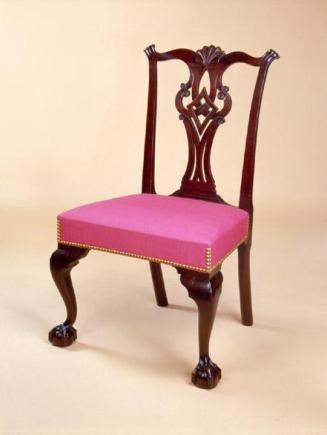Armchair
Furniture MakerMade by the shop of
Eliphalet Chapin
(American, 1741 - 1807)
Original OwnerOriginally purchased by
Ebenezer Grant
(Anglo-American, 1706 - 1797)
Original OwnerOriginally owned by
Ann Grant
(American, 1748 - 1838)
Original OwnerOriginally owned by
Reverend Dr. John Marsh
(American, 1742 - 1821)
ConservatorConserved by
Walton Antiques Inc.
(American)
Date1775
MediumCherry, red moreen wool, brass nails
DimensionsPrimary Dimensions (overall height x width x depth): 40 3/4 x 26 5/8 x 23 1/4in. (103.5 x 67.6 x 59.1cm)
ClassificationsFurniture
Credit LineGift of Frederick K. and Margaret R. Barbour
Object number1960.7.5
DescriptionCherry armchair in the Chippendale, or rococo, style, with a scalloped crest rail, a pierced, vase-shaped splat, cabriole front legs over claw-and-ball feet, and over-the-rails upholstery. The back of the chair is formed by a crest rail atop two stiles. The crest rail has a ribbed shell in the center, flanked by a cyma curve, or S-curve, and a ribbed ear. Centered below the crest rail is a pierced, vase-shaped splat, with interlocking C-scrolls, small carved scrolls, and a diamond. The front of the splat is carved to add depth to the interlocking shapes. The splat is joined at the bottom to a tapered splat shoe, just above the back seat rail. Above the seat, each stile is slanted back. Below the seat, each stile forms a cylindrical back leg that is slanted toward the center back of the chair as well. Each arm undulates and ends in an outward-scrolled handhold that extends past the side seat rails. The arm is supported by a curved arm support that extends down to the side of the front leg. The seat is trapezoidal, with over-the-rails red moreen wool upholstery (replaced). The upholstery is secured with a line of brass nails along the bottom front and side edges of the front and side seat rails. Each cabriole front leg extends from the height of the seat down to a claw-and-ball foot. Two knee brackets are located at the top of each front leg, where the leg joins the front or side seat rail. The diagonal edge of the knee bracket is shaped with a cyma curve.
Condition: The chair has been dismantled at the joint of the side seat rails and the stiles. The arms have been re-screwed, and the screws are concealed. The rear corner blocks are replaced. The top and bottom edges of the seat rails are repaired. The furthest projecting portions of the knees are scratched and lightly gouged. Some dented areas of the surface have been touched up. The frame is refinished. The upholstery and the wooden seat frame are replaced.
Design and Construction Details: The crest rail is supported on a tenon at the top of each stile. Above the seat, the back of each stile is rounded. The splat is tenoned into the crest rail; the lower center section of the back of the crest rail is glued in place and is shaped to conform to the pierced openings at the top of the splat. The splat is tenoned into the back seat rail. The splat shoe is nailed down onto the back seat rail; it has a cut-out to accommodate the bottom of the splat. Each arm rest is screwed into the stile; the screw is concealed with filler. The front of each arm rest is supported on a tenon at the top of the arm support; each arm support is screwed to the side of the seat frame just above the knee, and the screw is concealed with filler. Each end of the front and side seat rails extends down in a semi-circular curve to meet the knee bracket. The back seat rail is tenoned and double pinned into the stiles. Each side seat rail is tenoned through the stile; each of these joints is secured with two small wedges of wood inserted into the back of the tenon. The joints at the top of the front legs are covered by the upholstery. Each knee bracket is nailed to the underside of the front or side seat rail and to the side of the knees. The back interior corners of the seat frame have triangular corner blocks (replaced) nailed in place; the lower edge of each of these corner blocks is shaped to accommodate the shape of the seat rails. The front interior corners of the seat frame each have a vertical glue block and a triangular corner block nailed in place; these are also shaped to accommodate the shape of the seat rails.
Upholstery (replaced). The chair is upholstered with red moreen wool that is held in place over the rails with a row of brass nails along the bottom and side edges of the front and side seat rails (following the original nailing pattern). Additional tacks holding the upholstery in place are located on the underside of the front and side seat rails. Below the red wool is stuffing, sackcloth, canvas webbing, and a wooden frame.
Please see attached essay by the Chapin authority, Dr. Thomas P. Kugelman for more information about this piece.
Condition: The chair has been dismantled at the joint of the side seat rails and the stiles. The arms have been re-screwed, and the screws are concealed. The rear corner blocks are replaced. The top and bottom edges of the seat rails are repaired. The furthest projecting portions of the knees are scratched and lightly gouged. Some dented areas of the surface have been touched up. The frame is refinished. The upholstery and the wooden seat frame are replaced.
Design and Construction Details: The crest rail is supported on a tenon at the top of each stile. Above the seat, the back of each stile is rounded. The splat is tenoned into the crest rail; the lower center section of the back of the crest rail is glued in place and is shaped to conform to the pierced openings at the top of the splat. The splat is tenoned into the back seat rail. The splat shoe is nailed down onto the back seat rail; it has a cut-out to accommodate the bottom of the splat. Each arm rest is screwed into the stile; the screw is concealed with filler. The front of each arm rest is supported on a tenon at the top of the arm support; each arm support is screwed to the side of the seat frame just above the knee, and the screw is concealed with filler. Each end of the front and side seat rails extends down in a semi-circular curve to meet the knee bracket. The back seat rail is tenoned and double pinned into the stiles. Each side seat rail is tenoned through the stile; each of these joints is secured with two small wedges of wood inserted into the back of the tenon. The joints at the top of the front legs are covered by the upholstery. Each knee bracket is nailed to the underside of the front or side seat rail and to the side of the knees. The back interior corners of the seat frame have triangular corner blocks (replaced) nailed in place; the lower edge of each of these corner blocks is shaped to accommodate the shape of the seat rails. The front interior corners of the seat frame each have a vertical glue block and a triangular corner block nailed in place; these are also shaped to accommodate the shape of the seat rails.
Upholstery (replaced). The chair is upholstered with red moreen wool that is held in place over the rails with a row of brass nails along the bottom and side edges of the front and side seat rails (following the original nailing pattern). Additional tacks holding the upholstery in place are located on the underside of the front and side seat rails. Below the red wool is stuffing, sackcloth, canvas webbing, and a wooden frame.
Please see attached essay by the Chapin authority, Dr. Thomas P. Kugelman for more information about this piece.
Label TextThis chair is one of a set that was purchased from the shop of Eliphalet Chapin by Ebenezer Grant of East Windsor, for the wedding of his daughter Ann Grant of East Windsor, to the Reverend John Marsh, pastor Wethersfield's First Congregational Church. They were married on 6 December 1775.
Status
Not on view














